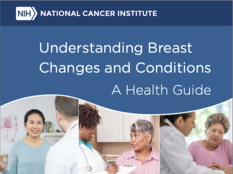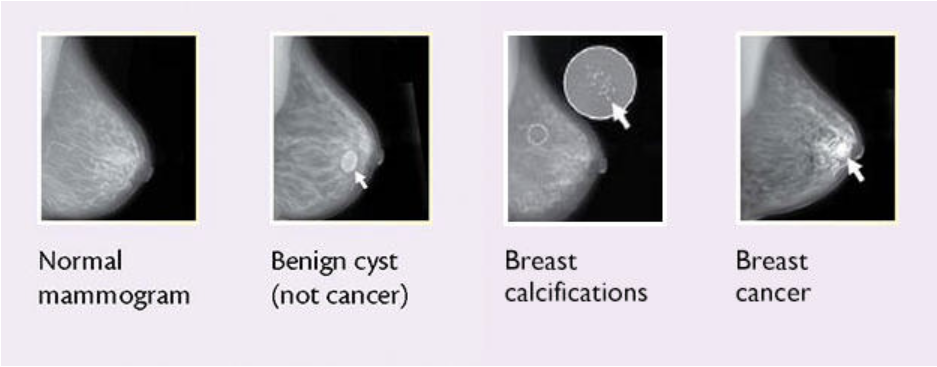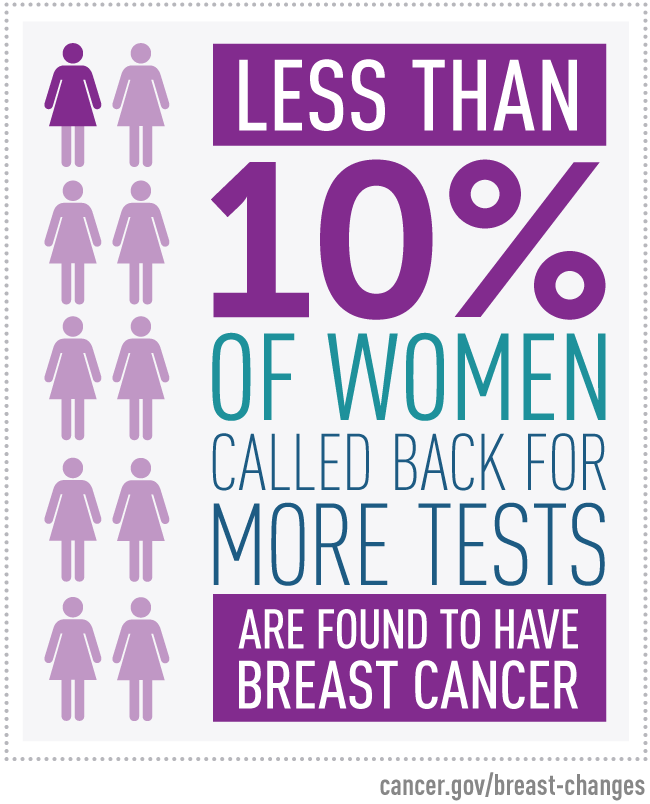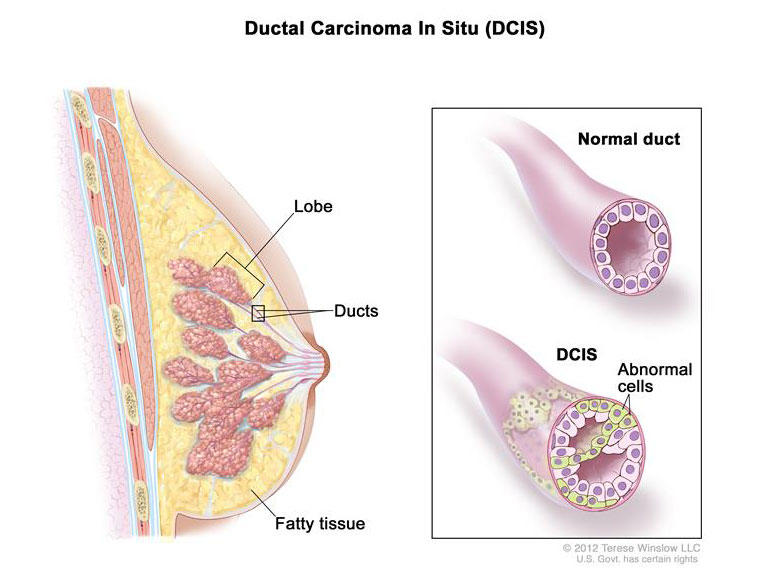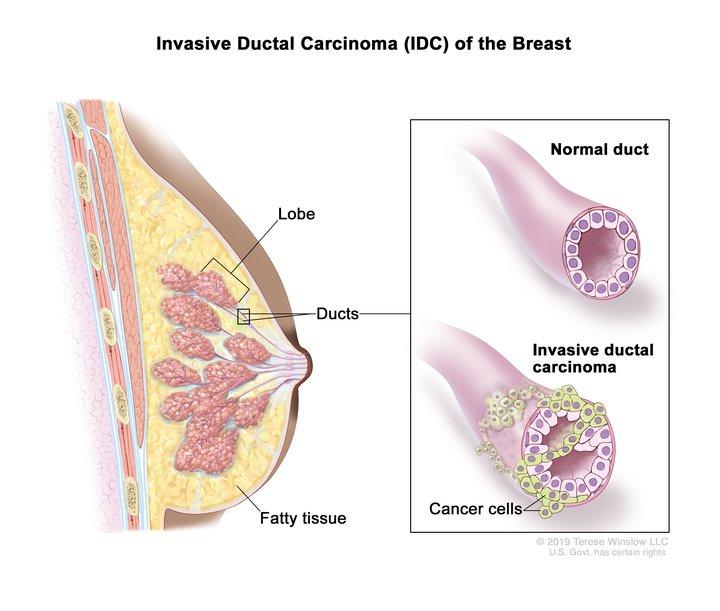Breast Health: Follow-up after an Abnormal Mammogram
You may have just received an abnormal mammogram result, or perhaps you or your doctor found a breast lump or other breast change. Keep in mind that breast changes are very common. Even though most breast changes are not symptoms of breast cancer, it’s very important to get follow-up testing after an abnormal mammogram result.
Breast lumps and changes during your lifetime
Most women notice changes in their breasts at different times during their life.
- Before or during your period (also called menstruation), your breasts may feel painful, swollen, or tender. You may feel one or more lumps before your period because of extra fluid in your breasts.
- During pregnancy your breasts may feel lumpy, or you may feel breast lumps. This is usually because the glands that produce milk are increasing in number and getting larger.
- As you approach menopause, your hormone levels change. This can make your breasts feel tender, even when you are not having your period. Your breasts may also feel lumpier during menopause than they did before.
- If you are taking hormones (such as hormone replacement therapy, birth control pills, or injections), your breasts may become more dense. This can make a mammogram more difficult to interpret.
- After menopause, your hormone levels drop. You may stop having lumps, pain, or nipple discharge.
It’s important to have breast lumps or other breast changes diagnosed. Always check with your doctor or nurse about breast changes.
Breast changes that may be caused by breast cancer
While these symptoms are often caused by benign breast conditions, they may be possible warning signs or symptoms of breast cancer. Check with your doctor or nurse if you notice unusual changes in your breast(s) such as a breast lump, nipple change, or skin changes.
Breast lump or firm feeling (also called a mass), including a lump in or near your breast, a lump under your arm, thick or firm tissue in or near your breast or under your arm, or a change in the size or shape of your breast. Breast lumps come in different shapes and sizes. Most lumps are not breast cancer.
Nipple changes or discharge, including fluid from the nipple that is not breast milk. Because nipple changes or discharge can sometimes be signs of breast cancer, they should be checked. However, nipple discharge can be caused by birth control pills, medicine, and infections.
Skin changes on your breast(s), including itching, redness or darkening, scaling, swelling, dimples, or puckers on your breast or nipple that don’t go away.
Keep in mind that while some breast changes can be felt or seen, others can only be found during an imaging procedure such as a mammogram, MRI, or ultrasound.
Finding breast changes
Being familiar with how your breasts normally feel, such as when you shower or put on a bra, can make it easier to notice any changes. However, doing routine breast self-exams has not been shown to decrease the chance of dying from breast cancer.
Follow up with your doctor or nurse if you notice a breast change—even if you are not due for a mammogram. Breast cancer that develops between mammograms is known as an interval breast cancer. These breast cancers tend to be larger, grow and spread more quickly, and have a worse prognosis than breast cancers that are found during a screening mammogram.
Mammogram results
A screening mammogram can find signs of breast cancer and tumors that are too small to feel.
- If your mammogram results were normal: Your breast tissue shows no signs of a mass or calcification.
- If your mammogram results were abnormal: An abnormal breast change was found. Although many breast changes found on a mammogram are benign (not cancer), it’s important to get the follow-up tests advised by your doctor or nurse.
- If you don’t get your mammogram results: Call your doctor or nurse.
Understanding your mammogram report
It’s important to understand your mammogram results. Don’t hesitate to call your doctor if you have questions about what your mammogram letter means. Be sure you understand the findings and the recommended next steps you need to take. Mammogram reports use the Breast Imaging Reporting and Data System (BI-RADS) to report findings, shown in the table below.
Breast Imaging Reporting and Data System (BI-RADS) |
||
|---|---|---|
Category |
Finding (assessment) |
Recommended next steps |
| 0 |
Need additional imaging evaluation |
Additional imaging needed before a category can be assigned |
| 1 |
Negative |
Continue regular screening mammograms |
| 2 |
Benign (not cancer) |
Continue regular screening mammograms |
| 3 |
Probably benign |
Receive a 6-month follow-up mammogram |
| 4 |
Suspicious abnormality |
May require biopsy |
| 5 |
Highly suggestive of malignancy (cancer) |
Requires biopsy |
| 6 |
Known biopsy-proven malignancy (cancer) |
Biopsy confirms presence of cancer before treatment begins |
Learn more and get answers to commonly asked questions about mammograms.
What can a mammogram show?
Mammograms can show a mass (breast lump), calcification, and other changes; they also show breast density. The radiologist will study the mammogram for changes that do not look normal and for differences between your breasts. When possible, your most recent mammogram will be compared with past mammograms to check for changes in breast tissue since your last mammogram.
Mass (also called a breast lump): The size, shape, and edges of a lump give the radiologist important information. A lump that is not cancer often looks smooth and round and has clear, defined edges. Lumps that look like this are often cysts and are not cancer. However, if the lump on the mammogram has a jagged outline, an irregular shape, or other unusual features, it is of more concern and more tests may be needed.
Calcifications are deposits of calcium in the breast. They are too small to be felt but can be seen on a mammogram. There are two types:
- Macrocalcifications look like small white dots on a mammogram. They are often caused by aging, an old injury, or inflammation and are usually benign (not cancer).
- Microcalcifications look like white specks on a mammogram. If found in an area of rapidly dividing cells or grouped together in a certain way, they may be a sign of DCIS or breast cancer. Calcium in your diet does not cause breast calcifications.
Breast density is a description of the relative amounts of dense and fatty tissue on a mammogram. Mammography is less sensitive in women with dense breasts—that is, it is more likely to miss cancer. Women with dense breasts also have an increased risk of developing, but not dying from, breast cancer. Learn what it means to have dense breasts.
Follow-up tests to diagnose the cause of abnormal mammogram results
The procedures and tests listed below may be recommended by your doctor or nurse to diagnose a breast change that was found on a mammogram or a breast lump that you or your doctor or nurse felt.
Breast imaging procedures
Breast imaging procedures take detailed pictures of areas inside the breast. The results of the breast imaging tests listed below, and the expertise of the radiologist interpreting your tests, are important for an accurate diagnosis.
Diagnostic mammogram: A procedure used to check for breast cancer after a lump or other sign or symptom of the disease has been found. More x-ray pictures of the breast are taken from different angles to allow an area of the breast to be examined more closely.
Ductography (also called galactography): A procedure that takes pictures of the breast ducts so that doctors can learn more about certain kinds of abnormal nipple discharge or a breast mass. Pictures are taken using a contrast material that is given through an injection to help breast ducts show up clearly.
Magnetic resonance imaging (MRI) of the breast: A procedure in which radio waves and a powerful magnet linked to a computer are used to create detailed pictures of areas inside the breast. An MRI can help your doctor learn more about a breast mass or enlarged lymph nodes that were found during a clinical breast exam but were not seen on a mammogram or ultrasound.
Ultrasound of the breast: A procedure that that uses high-energy sound waves to look at tissues and organs inside the body. The sound waves make echoes that form images (called a sonogram) of the tissues and organs on a computer screen. These images can show if a breast lump is solid or is filled with fluid.
Breast biopsy
When an imaging procedure shows an abnormal breast change, a biopsy may be needed to make a definitive diagnosis. Some types of biopsies may also be used as treatment.
Your doctor will talk with you about the type of biopsy, why it’s needed, and what to expect during and after the procedure.
Needle biopsy is a procedure that removes cells, small tissue samples, or fluid so that it can be examined under a microscope.
- A fine-needle aspiration biopsy uses a thin needle to drain fluid or to remove cells.
- A core needle biopsy (also called a core biopsy) uses a wide needle to remove small tissue sample(s) that are about the size of a grain of rice.
- A vacuum-assisted core biopsy (also called a vacuum-assisted biopsy) is used to remove a small sample of breast tissue with a probe that is connected to a vacuum device. The tiny cut made in the breast is much smaller than with surgical biopsy.
Surgical biopsy is a procedure that removes breast tissue so that it can be examined under a microscope.
- An incisional biopsy procedure removes a sample of breast tissue.
- An excisional biopsy procedure removes the entire lump or suspicious area.
- A wide local excision is used to cut out a tumor or other abnormal lesion and some normal tissue around it.
Sometimes an imaging procedure is used to help a surgeon find and remove an abnormal area during a biopsy. A stereotactic biopsy uses mammography; there are also ultrasound-guided biopsies and MRI-guided biopsies.
Commonly asked questions about a breast biopsy
Where are breast biopsy procedures done?
Breast biopsies are usually done in a doctor’s office, clinic, or hospital on an outpatient basis. This means you will go home the same day as the procedure.
Will anesthesia be used during this breast biopsy?
Anesthesia will be used so you won’t feel pain during a breast procedure. The type of anesthesia used depends on the procedure. Local anesthesia causes the loss of feeling in a small area, so you’ll be awake but won’t feel pain during the procedure. Regional anesthesia is used to cause a temporary loss of feeling in a region or part of the body. General anesthesia causes you to be asleep during the procedure.
What is a wire localization procedure?
Wire localization (also called needle localization and needle/wire localization) is a procedure used to mark a small area of abnormal tissue to be removed. An imaging device is used to guide a thin wire with a hook at the end through a hollow needle to place the wire in or around the abnormal area. The wire is removed when a biopsy is done.
What is a breast biopsy clip?
A breast biopsy clip (also called a breast biopsy marker) is a tiny metal object that is placed into the breast during a biopsy to mark the area where the biopsy was done. The clip or marker is left inside the breast to identify the area on future imaging exams or to help locate the site in the event that breast cancer is diagnosed, and surgery is required. The clip does not cause pain or harm and can stay in the breast. However, if the abnormal area is removed, the clip or marker will often be removed as part of the surgery.
Benign lumps and other benign breast conditions
Benign breast conditions are not cancer, although some of them may slightly increase the risk of cancer. They may be referred to as benign breast disease or nonmalignant breast conditions.
Breast conditions that do not increase breast cancer risk
Below are common benign breast conditions (and their symptoms) that don’t increase your risk of breast cancer.
Adenosis: A breast condition in which there are enlarged breast lobules that may cause small round lumps or lumpiness. Or you may not feel anything at all.
Breast cysts: Closed, saclike pockets of tissue that can form in the breast. Most breast cysts are filled with fluid and called simple cysts. They may be painful just before your menstrual period begins. You may be able to feel a cyst, although some are too small to be felt. Cysts are most common in premenopausal women and in women taking menopausal hormone therapy
Breast duct ectasia (also called mammary duct ectasia): A breast condition in which one or more breast ducts widens and thickens. This can cause the duct to become blocked with fluid. It may sometimes cause whitish, greenish, or blackish nipple discharge, tender or darker nipples, or inverted nipples. If the blocked duct becomes infected, you may feel a lump under the nipple. Breast duct ectasia is a benign breast condition that is most common in women who are approaching or have gone through menopause.
Breast hematoma: A pool of clotted or partially clotted blood under the skin of the breast that may cause a lump, fever, and breast inflammation. Hematomas are usually caused by a broken blood vessel after an injury or surgery to the breast. They can also occur without injury in people taking aspirin or blood thinners.
Fat necrosis of the breast: A condition that causes round, firm, usually painless lumps. Fat necrosis may appear after an injury to the breast, surgery, or radiation therapy. Skin around the lump may look red, bruised, or dimpled.
Fibroadenoma: Benign breast tumors that often feel like hard, round lumps in the breast and move easily. Fibroadenomas don’t usually hurt and may sometimes be too small to be felt. Fibroadenomas are the most common benign breast tumors in women under 30 years old, although they can be found at any age. These tumors may get larger when estrogen levels increase (during pregnancy or with hormone replacement therapy) and smaller during menopause.
Fibrocystic breast disease (also called fibrocystic breasts and fibrocystic breast changes): A common breast condition in which you may have breast swelling or discomfort, sensitive nipples, nipple discharge, and itching. You may also have a mass (also called lumps) or cysts. Symptoms often start before or during your menstrual period. As many as half of all women notice fibrocystic breast changes. Fibrocystic breasts are most common among women under the age of 45 and among women taking hormone replacement therapy.
Intraductal breast papilloma (also called intraductal papilloma): A breast condition that causes wartlike growths in the breast duct. Single intraductal papillomas are usually close to the nipple and may cause a lump, pain, and clear or bloody discharge.
Lipoma of the breast: A benign tumor made of fat cells. It’s usually a painless, single, soft lump.
Mastitis: A painful breast condition that is most common in women who are breastfeeding. It’s caused when a breast duct (also called a milk duct) becomes blocked or infected. Your breast may look red or darker and feel lumpy, warm, and tender. You may also have nipple discharge and a fever or flu-like symptoms.
Breast conditions that may increase breast cancer risk
These benign breast conditions are not breast cancer, although they may slightly increase your risk of breast cancer. They may also never cause health problems or cancer in the future.
Complex fibroadenomas: A type of benign tumor that usually forms in the breast and is made up of fibrous and glandular tissue. Other abnormal tissue changes such as cysts, calcifications, scar-like tissue, and hyperplasia are also present. Complex fibroadenomas are more common in older women.
Multiple intraductal breast papillomas (also called intraductal papillomas): A breast condition that causes wartlike growths in the breast duct. They may not be felt or cause nipple discharge. They are smaller and often found farther away from the nipple than a single intraductal breast papilloma.
Radial scars (also called complex sclerosing lesions): A type of benign tissue that looks like a scar when viewed under a microscope. Often, multiple lesions are seen in both breasts. Radial scars cannot usually be felt and rarely cause symptoms.
Sclerosing adenosis: A condition that doesn’t usually cause symptoms, although you may notice a small lump or breast pain. Scar-like fibrous tissue is found in the breast lobules.
Precancerous breast conditions
A precancerous condition is one that is not cancer but may become cancer. If you are diagnosed with one of these conditions, you have a higher risk of breast cancer. The risk of developing breast cancer is lower for atypical ductal hyperplasia (ADH) and atypical lobular hyperplasia (ALH) than for pleomorphic lobular carcinoma in situ (PLCIS) and lobular carcinoma in situ (LCIS).
Atypical ductal hyperplasia (ADH): A breast condition in which there are more cells than usual in the breast ducts and the cells look atypical (abnormal) under a microscope. ADH may increase your risk of breast cancer.
Atypical lobular hyperplasia (ALH): A breast condition in which there are more cells than usual in the breast lobules and these cells look atypical (abnormal) under a microscope. ALH may increase your risk of breast cancer.
Lobular carcinoma in situ (LCIS): A breast condition in which abnormal cells are found in the breast lobules. There are more abnormal cells in the breast lobule with LCIS than with ALH. LCIS increases your risk of developing cancer in either breast.
Pleomorphic lobular carcinoma in situ (PLCIS): A breast condition in which abnormal cells are found in the breast lobules. These cells are often larger and more abnormal than in LCIS. PLCIS is more likely to become invasive breast cancer than LCIS. PLCIS occurs most often in postmenopausal women.
Ductal carcinoma in situ (DCIS)
Ductal carcinoma in situ (DCIS) is a noninvasive breast condition in which abnormal cells are found inside the breast duct but have not spread outside it. DCIS is also called intraductal breast carcinoma or stage 0 breast carcinoma in situ. Although the cells are abnormal, they are not considered cancer because they do not have the ability to break through the duct wall or spread in the body, which is the definition of cancer. DCIS may sometimes become invasive breast cancer and spread to other tissues.
Doctors diagnose some cases of DCIS as being at lower risk of becoming invasive than others. However, since doctors don’t currently know for sure which cases of DCIS will become invasive cancer and which ones won’t, DCIS is almost always treated. Because research is ongoing and you have choices about treatment, it may be helpful to get a second opinion, discuss your treatment options with more than one doctor, and learn about clinical trials for DCIS.
DCIS and Clinical Trials
You can find DCIS treatment clinical trials by typing in “DCIS” as a keyword into NCI-Supported Clinical Trials. One nationwide DCIS clinical trial (Comparing an Operation to Monitoring, with or without Endocrine Therapy (COMET) is comparing active monitoring with surgery in women with low-risk DCIS.
Where can I learn more about breast cancer?
Breast cancer (also called invasive breast cancer) is a disease in which cancer cells form in the tissues of the breast. Breast cancer is not just one disease. There are different breast cancer subtypes.
In breast cancer, cells grow and divide without control and invade nearby breast tissue.
Cancer cells may also form a mass called a tumor and metastasize (spread) to the lymph nodes or other parts of the body. Invasive ductal carcinoma is the most common type of breast cancer.
Learn more about breast cancer, including treatment options, on NCI’s breast cancer home page.

